“The City’s Most Everything Lady,” the Renaissance Center
“On the eve of her first day, she was obviously nervous. She primped all night long. She was mopped and vacuumed, polished and dusted, wiped squeaky clean and garlanded with $6,000 worth of fresh yellow mums. She was fluffed, patted, and fussed over.”
–Detroit News article, “Plaza Debut Here at Last,” written by John McAleenan March 16, 1977
Even if you’ve never heard of it before, the name “Renaissance Center” sounds very sad. The above is a quote from the article published in the Detroit News announcing that the Renaissance Center, which had been in the works since 1971, was at last up and running and had opened, the previous day (March 15, 1977), to an enormous gala celebration. The “she” referred to in the quote is the Renaissance Center herself, a rosette of four 37-story towers (with two added since) encircling a 73-story central tower in downtown Detroit, situated in an idyllic spot on the Detroit River.
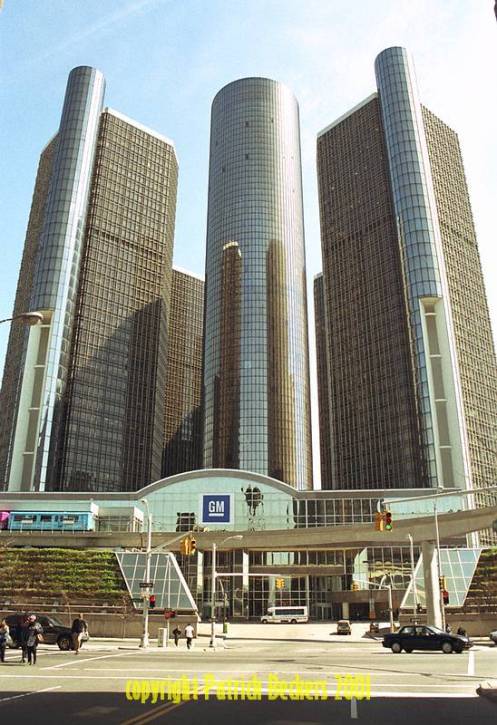
Here’s how the Ren Cen looks from across the river, in neighboring Windsor, Canada:
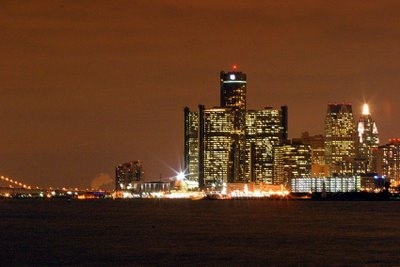
The central tower is the tallest building in Michigan; it houses a hotel, the Marriott at the Detroit Renaissance Center, which at 73 stories is the tallest all-hotel building in the Western hemisphere. And inside those 73 stories, the Ren Cen offers 1,298 rooms for the discerning traveler to choose from.
Yet the owner of the Renaissance, since 1996, is General Motors. Marriott, in the central tower, is only GM’s tenant, and the other six towers are but tentacle-shoes for various tentacles of GM’s epic corporate leviathan.
Therefore, the first thing that you see when you walk into the Renaissance Center is cars. They are arranged in the cavernous ground-floor atrium in a way that is half showroom, half art exhibit. There are big signs around that say “GM re: invention” that encourage you to think of the cars on view as examples of how GM is reinventing itself currently. For this reason, “GM re: invention” is somewhat of a misnomer; “GM re: reinvention” would more accurately convey an impression of what the exhibit is trying to convey.
Click on this for videos that explain GM’s reinvention more thoroughly than I ever could:
<embed src=”http://blip.tv/play/gjSBj7Frg7Iw” type=”application/x-shockwave-flash” width=”600″ height=”400″ allowscriptaccess=”always” allowfullscreen=”true”></embed>
What’s fascinating about the Ren Cen is that the minute you step inside, it’s like you’re entering an alternate universe where the U.S. automotive industry in general and GM in particular are blazing ahead into the future, still leading the world in every possible sense, and in no way totally demoralized and humiliated by decades of poor management, inferior product, and constant layoffs.
Meet the 2010 Buick LaCrosse:

The difference between that LaCrosse, and all those that precede it, is that it will save GM, America, and the world. Same for the 2010 Chevy Camaro:
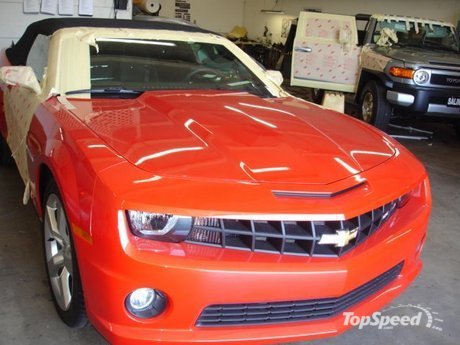
GM is also preparing an electric car for release in 2010, the Volt. It looks like a cartoon character, a Michael Bay-Pixar collaboration, but if GM can make it work I won’t be upset.

The ground-floor atrium of the Renaissance Center is given over to showcasing these and many other new GM cars with messianic seriousness. The irony here is that they are in the Renaissance Center, which was supposed to do things for Detroit itself that were similar to the 180-degree transformative miracles th these cars are scheduled to do for GM next year.
Maybe it’s no accident that they’re together. Maybe the Ren Cen’s scenic spot on the Detroit Riverfront is not a real place at all, but just a metaphysical plane where lost hopes go to get buffed, shined, shimmered, and glitzed ad infinitum.
The Ren Cen was built in 1977, in the same general time frame as NYC’s World Trade Center (North Tower 1970, South Tower 1971), and for the same basic purpose: to attract new business to the city/keep business already in the city from fleeing to the suburbs, the Sun Belt, overseas, or wherever. According to an article published in the Detroit News when the Ren Cen was almost ready to open for business (March 6, 1977–“The Detroit Plaza: Opening is near–here’s a preview”) the consortium of 51 businesses and individuals, spearheaded by Henry Ford II, who provided the Ren Cen project with financial backing was “the largest private investment group ever assembled in the United States for a major real-estate development”. The hopes of the Detroit business community were behind the Ren Cen, designed by architect John Portman as “city within a city” so huge that the regional business community could seek refuge there in its entirety and be protected, should the people of Detroit ever revolt against them again.
When the Ren Cen first opened, GM occupied dozens of floors and Ford an entire tower. Importantly, though, the other tenants were from the industries of finance, insurance, and real estate (FIRE): Arthur Andersen and Co., Equitable Life Insurance Co., Manufacturers National Bank, and the National Bank of Detroit were among the companies using space there, suggesting that the Renaissance Center could at one time have become a kind of glass-enclosed Wall Street of Detroit’s own. Not Ford or GM, but a law firm, Colista, Green, Green, and Adams, was the very first tenant to acquire office space there.
To my mind, it seems evident that the original dream of Henry Ford II and his cohorts in the planning of the Renaissance Center had been to provide the home base of a FIRE economy for postindustrial Detroit. Because of the involvement of car companies in the Ren Cen project, this is hard to verify for sure, but still it seems like the basic Ren Cen plan would provide all the necessary features of a FIRE-dominated central business district. In “The Global City,” Saskia Sassen stresses the importance of sheer physical contiguity between highly specialized firms, whose level of specialization often requires extensive collaboration, and the Ren Cen would certainly be able to provide that. Firms squirreled away in any one of the shorter towers would not even have to cross the street to give face time to their partners and rivals in any of the other firms, and all of the firms’ visitors and clients could stay in swanky hotel rooms in the central tower. Of course, Sassen never argues that these firms must be enclosed within the glass walls of a single structure–a biosphere for suits–in order for a central business district to be successful.
In any case, if the original dream of the Renaissance Center was indeed to create a home base for a FIRE economy in postindustrial Detroit, that dream died long ago. GM bought the Ren Cen in 1996; by 2004, the Ren Cen had been renovated, the better to meet GM’s vaunted quality standards. Besides GM and the Marriott, there is now a movie theater (the “Ren Cen 4”), Starbucks, a cocktail lounge, and the Food Court in the Ren Cen.
Later in the same article quoted at the beginning of this post, John McAleenan of the Detroit News continues to recount the Renaissance Center’s nervous feelings on the eve of her big March 15, 1977 coming-out party:
“On the eve of her first day, she was obviously nervous. She primped all night long. She was mopped and vacuumed, polished and dusted, wiped squeaky clean and garlanded with $6,000 worth of fresh yellow mums. She was fluffed, patted, and fussed over.”
McAleenan writes of how Mayor Coleman A. Young Governor William J. Milliken were present to commemorate the occasion. And not only that, but, “hundreds of other dignitaries, workers, and area residents were on hand for the opening of the city’s newest, brightest, tallest, most everything lady.”
Originally, 13 restaurants had been planned for the atrium area of the Ren Cen, most of which were high-end. Today, the same space is occupied by the aforementioned Food Court, which hosts Burger King, McDonald’s, a Chinese place, a Mexican place, a Greek place, and, best of all, Detroit’s very own Coney Island dogs. During my visit to the Ren Cen Food Court, I savored a Coney Island dog to my great satisfaction.

For those not in the know, Detroit is famous for Coney Island Hot Dogs. Simmer down, New Yorkers: I know that Coney Island is as well. But in Detroit, Coney Island is a venerated hot dog chain that serves a particular style of hot dog, draped in chili the way that the Renaissance Center towers a draped in glass, and sprinkled with onions the way that sunlight glitters on the glass of the Renaissance Center on a sunny day.
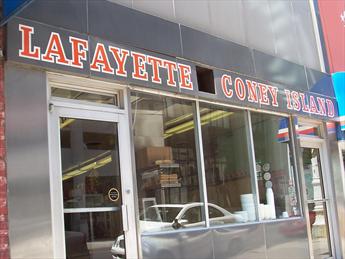
When the Renaissance Center first opened, the central tower hotel was operated not by Marriott, but by Western International Hotels, and it was called the Detroit Plaza Hotel. Accordingly, McAleenan strikes chords that are equal parts Titanic and Overlook when he waxes rhapsodic over architect Portman’s monumental shrine to what Kevin Saunderson would call the “good life”:
“The most stunning part of the Plaza Hotel is an eight-story lobby (called an atrium) crowned by an enormous skylight and criss-crossed by five levels of aerial walkways. It comes complete with a waterfall that tumbles down a three-story pylon fountain.”
The maze of walkways, landings, escalators, and alcoves is still there today. It’s part of what makes the Ren Cen fun for a visit, really–the central tower is so confusing at the atrium level that it is literally a “fun house.” And for all the changes that the Ren Cen has been through, I think that McAleenan gets it right here when he notes that there is something so fundamentally alien and perverse about the Ren Cen that it has to have beamed in either from the distant past or the distant future:
“The effect is a mixture of medieval Great Hall and Space City. Raw, bark-textured cast concrete is molded in 18 curved ‘pods’ overhanging a half-acre lake on the promenade level.”
McAleenan explains the pod concept more precisely:
“The pods are little balconies that seat people so they can look at other people while they sip cocktails.”
Nice. What the pods really are, though, are cars. They transform the cocktail lounge/bar experience the same way that cars limit contact between people in cities. The pods are fun to look at from the higher levels and cozy to sit in–just like cars can be at times–but they also carry the vision of relationships between human beings that the Big Three have bequeathed to us to a remarkable extreme. It is as though enhanced transportation had been only a means to an end for the industry, and the real objective had all along been increased social atomization in every form.
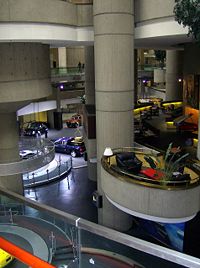
After I bought my hot dog I carried it out of the atrium, into a big Winter Garden that GM built as part of its renovation of the Cen. It is a wide open space, decorated with palm trees, that ends in a colossal glass wall with a beautiful view of the Detroit River and, beyond it, Windsor.
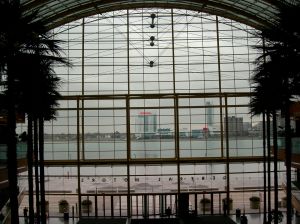
There were a few tables scattered around. I found one that faced the river, but close to the back so I could take in a bit of the Winter Garden itself as well. As I savored my Coneys and tried unsuccessfully to get on GM Wi Fi, I noticed two businesswomen sitting a little ways to my right. One of them, with black hair in a black business suit, wouldn’t stop talking: she kept getting more animated from one second to the next, but her friend/colleague was game, nodding rhythmically along with the other’s speech whenever (I imagined) it was appropriate.
It could be that the woman in the black suit was not a GM executive, but I imagined for a second that she was. She looked like she was about my age, and I don’t know anyone my age who is interested in becoming an auto executive. She seemed so into what she was talking about, though, that I asked myself: Well, why not work for GM? Then I remembered.
But that didn’t stop me from speculating that the woman had always harbored a wholly naive, idealistic love of cars. When I was a kid, I used to really enjoy going out at night and looking at the stars: that kind of thing. She has no phallic issues, she is not trying to replace a father or a boyfriend in any way. She is just very interested in cars themselves and how they work, are produced, maintained, promoted, sold, and so on.
I experienced a momentary surge of innocent joy at the thought of cars, and that is the type of feeling that the Ren Cen enables at its best. The possibility that anyone can feel that way about cars, no matter what their background, without any trace of ulterior motive. The Ren Cen is a modernist structure, and, like all modernist works, it exhibits faith in the idea that a radical break from the past is possible under the right circumstances.
That’s what the building is, and that’s the way it’s supposed to make you feel. That’s also the problem: it’s at cross purposes. A radical break with the past and a rebirth have nothing to do with each other. The Ren Cen feels like the site of a birth, period–a Naissancenter–and what’s more the sinister birth of a race of sentient cars. Worse still, I have the feeling that cars like that–or like the shiny 2010 models dispersed throughout the atrium, at any rate–would drive as far from Detroit as they possibly could, if they could think and had a choice in the matter. Just like the employment opportunities once offered to the people of Detroit by the corporations that designed those cars.

[…] to go to Bar One, in the Ren Cen’s spacious atrium, where we would have been able to sit in the pods arrayed around Bar One as an homage to the isolation and alienation that the invention of the car […]
The People Mover « Borrowed City: A New Yorker Spends a Month in Detroit said this on August 18, 2009 at 5:51 pm |